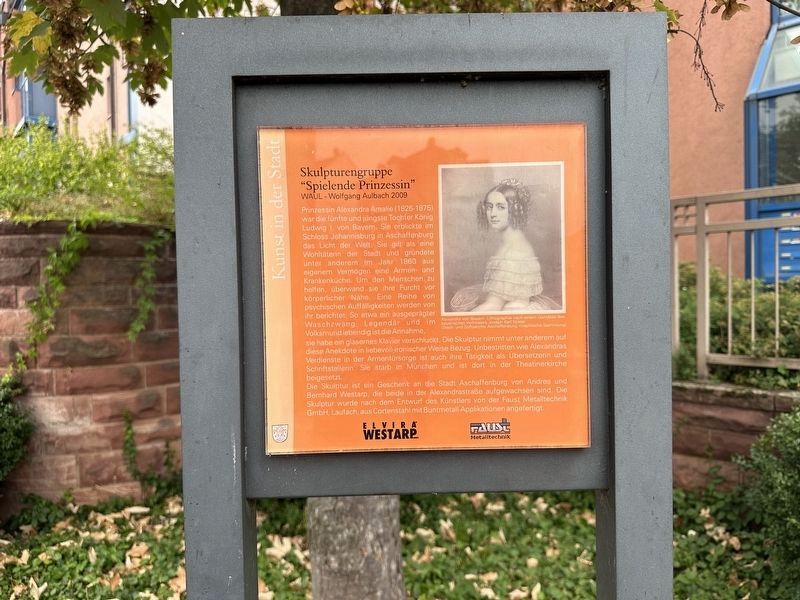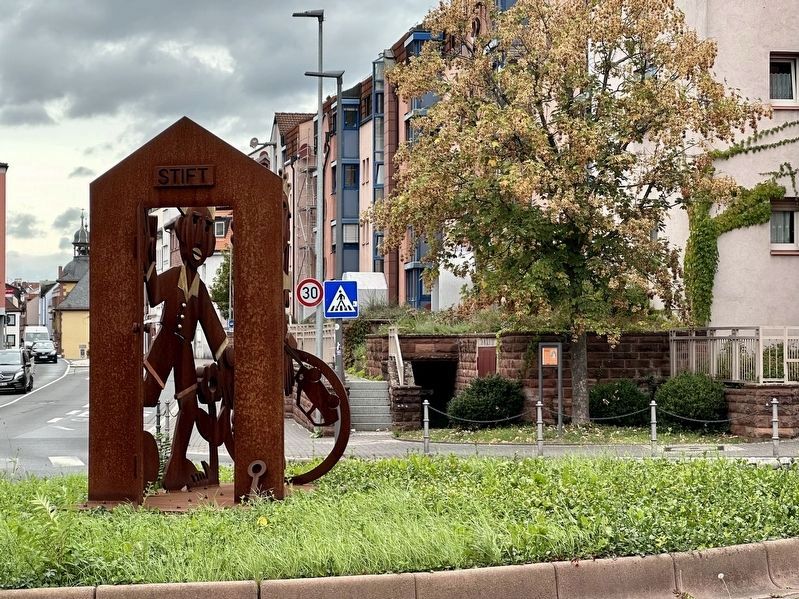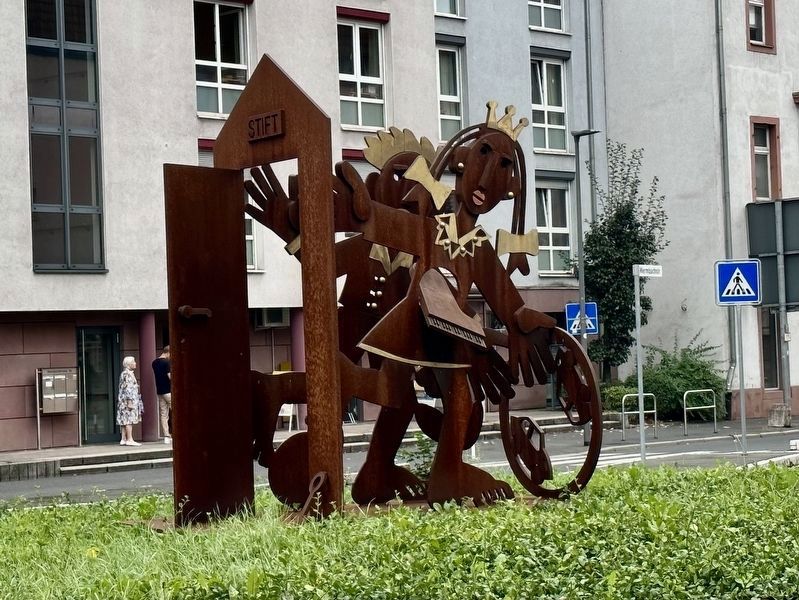Aschaffenburg, Bavaria, Germany — Central Europe
Prinzessin Alexandra Amalie / Princess Alexandra Amalie
Skulpturengruppe “Spielende Prinzessin” WAUL Wolfgang Aulbach 2009
— Kunst in der Stadt / Art in the City —
Inscription.
Die Skulptur ist ein Geschenk an die Stadt Aschaffenburg von Andrea und Bernhard Westarp, die beide in der Alexandrastraße aufgewachsen sind. Die Skulptur wurde nach dem Entwurf des Künstlers von der Faust Metalltechnik GmbH, Laufach, aus Cortenstahl mit Buntmetall-Applikationen angefertigt.
Princess Alexandra Amalie (1826-1875) was the fifth and youngest daughter of King Ludwig I of Bavaria. She was born in Johannisburg Castle in Aschaffenburg. She is considered a benefactor of the city and, among other things, founded a kitchen for the poor and the sick in 1860 with her own money. In order to help people, she overcame her fear of physical contact. She reported a number of psychological problems. For example, a pronounced compulsion to wash. There is a legendary and popular belief that she swallowed a glass piano. The sculpture refers, among other things, to this anecdote in a loving and ironic way. Her work as a translator and writer is as undisputed as Alexandra's achievements in poor relief. She died in Munich and is buried there in the Theatinerkirche.
The sculpture is a gift to the city of Aschaffenburg from Andrea and Bernhard Westarp, who both grew up on Alexandrastraße. The sculpture was made according to the artist's design by Faust Metalltechnik GmbH, Laufach, from Corten steel with non-ferrous metal applications.
Erected by Stadt Aschaffenburg.
Topics. This historical marker is listed in these topic lists: Arts, Letters, Music • Charity & Public Work • Women. A significant historical date for this entry is August 26, 1826.
Location.
49° 58.344′ N, 9° 9.011′ E. Marker is in Aschaffenburg, Bayern (Bavaria). Marker is at the intersection of Alexandrastraße and Wermbachstrasse, on the right when traveling south on Alexandrastraße. Touch for map. Marker is at or near this postal address: Alexandrastraße 14, Aschaffenburg BY 63739, Germany. Touch for directions.
Other nearby markers. At least 6 other markers are within walking distance of this marker. Schmerlenbacher Klosterhof / Schmerlenbach Convent (about 180 meters away, measured in a direct line); Aschaffenburg (approx. 0.3 kilometers away); Stiftsbrunnen / Collegiate Church Fountain (approx. 0.4 kilometers away); Dr. Johannes Kirsch (approx. 0.4 kilometers away); Ehemaliger Ballsaal / Former Ballroom (approx. half a kilometer away); Peter Gingold (approx. half a kilometer away).
Also see . . .
1. Princess Alexandra of Bavaria (Wikipedia).
Overview: Princess Alexandra Amalie of Bavaria (26 August 1826 – 21 September 1875) was a German princess and writer.(Submitted on October 20, 2023.)
2. The princess who thought she was made of glass (BBC Culture, May 16, 2019). The BBC’s article on the princess and the play about her (“The Glass Piano”) provides some insight into the “glass delusion”.
The “glass delusion”: The glass delusion was well-known enough to crop up briefly in Robert Burton's The Anatomy of Melancholy(Submitted on October 20, 2023.)in 1612, in a long passage of paranoid anxieties: “Fear of devils, death, that they shall be so sick, of some such or such disease, ready to tremble at every object… that they are all glass, and therefore will suffer no man to come near them.”
The glass delusion was common from the middle ages until about the 19th Century – and it seems it has an antecedent in a delusion of being made of pottery. “Classical and Medieval accounts of Earthenware Men abound”, wrote Gill Speak in a 1990 essay on the subject in the journal History of Psychiatry. But glass – this special, highly prized, almost alchemical substance – took over as the obsession du jour. The fear of being too fragile for this world was believed to be especially common among the nobility, as well as educated men, who may have read medical accounts of the delusion before ending up developing the symptoms themselves.
Credits. This page was last revised on October 20, 2023. It was originally submitted on October 20, 2023, by Andrew Ruppenstein of Lamorinda, California. This page has been viewed 95 times since then and 15 times this year. Photos: 1, 2, 3. submitted on October 20, 2023, by Andrew Ruppenstein of Lamorinda, California.


